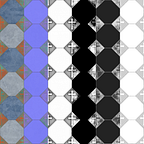How We Use Substance Designer to Power the GT Pipeline
There are some programs that come out and become and absolute mainstay in the industry, Allegorithmics Substance Designer is definitely one of those.
Launched in 2010 by Allegorithmic after nearly a decade of being immersed in and helping to shape the burgeoning procedural texture creation side of the industry. Substance Designer is a powerful texture authoring tool that allows the user to create fully procedural textures that are able to be used in any program that accepts bitmap images.
GameTextures.com uses Substance Designer as the primary material creation tool. The massive 4,000 material library is designed around and motivated by the power behind every substance and the potential found there.
Beautiful materials can be created in a ton of different ways. Substance Designer allows for a level of control and cohesion that can require a lot of know-how and can have a significant bar for entry to developing.
The program is a good example of easy to learn but difficult to master. The bar for entry is low with the mix of a solid UI and a high amount of control over you layouts but learning the best use for the different nodes is where patience and practice takes over.
Substance Designer allows the user to set up controls tied to various nodes.
You can output at any resolution up to 8k and in a large array of file formats.
The types of materials that can be created is varied, the limit really is on you. In this article alone I am showcasing a metal and tile mix as well as a hotel carpet material.
My coworkers have created everything from Brick to plastics and ground materials.
Our scanned materials are also created in Substance Designer, we can put the scanned images together into a procedural hybrid materials you know and love on the site.
We use the graph editor to manipulate shapes, build and blend layers of material and tell its story, whatever that is.
Creating great textures is all about creating stories, telling stories. You need to be able to manipulate a material at any and all levels to develop the history and depth needed to tell these stories without speaking a single word.
Substance Designer is a very important tool in the CG industry, textures are used for everything from Games, Movies and Architectural Visualization.
Picking the program up and getting familiar with material creation even if you are not intending to create textures for a living is important and I would say highly suggested.
Some Pros to force your hand
- Procedural Material authoring is the standard now, not the rule so finding ways to do it well is how to secure a future in this sector of the industry.
- With the automation toolkit, substance authoring can be built into your pipeline at any level.
- The results are fantastic.
Some cons to take away.
- For some it can feel less like art and more like programming.
- Updates have a bad habit of breaking part of your pipeline if not careful.
Marketplace Link
